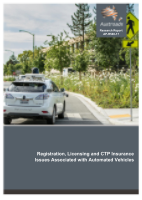Registration and Licensing

- Publication no: AP-R540-17
- ISBN: 978-1-925451-60-3
- Published: 14 March 2017
- PDF (free) Download
This report considers the potential impacts on vehicle registration, driver licensing and compulsory third party (CTP) insurance arrangements that might arise from the introduction of automated vehicles (AVs) in Australia and New Zealand.
The key vehicle registration issues identified revolve around vehicle standards, compliance at market entry, compliance in-service and vehicle ownership. The key driver licensing issues revolve around driver training, driver testing and licensing. For CTP insurance, the critical issues concern the impact of AVs on no-fault and at-fault schemes, the impact of no driver being in the vehicle if a crash occurs, the impact of changing vehicle ownership models, the assignment of liability, and the impact on insurance premiums and determination of risk.
The report examines the rules and processes put in place by overseas and local jurisdictions to facilitate the testing and deployment of AVs on public roads, and assesses their relevance and suitability to Australia and New Zealand. It concludes that the registration and driver licensing processes examined were generally suitable for supporting trials and deployment of AVs but that some amendments would be required as we progress towards supporting market deployment.
CTP rules and processes adopted in other jurisdictions do not seem directly relevant and suitable for adoption here and in New Zealand.
The report provides guidance to Austroads’ road agency members and other key stakeholders on the changes required to support the testing of AVs on public roads in the short term and the mass?market deployment of AVs in the longer term.
- Summary
- 1. Introduction
- 1.1. Purpose/Objectives of the Report
- 1.2. Methodology
- 1.3. Scope
- 1.4. Structure of Report
- 2. Automated Vehicles
- 2.1. Introduction
- 2.2. Defining Automated Vehicles
- 2.3. Levels of Automated Driving
- 2.3.1. Level 2 – Partial Automation
- 2.3.2. Level 3 – Conditional Automation
- 2.3.3. Level 4 – High Automation
- 2.3.4. Level 5 – Full Automation
- 2.3.5. Update of SAE Taxonomy
- 2.4. Timelines for AV Deployment
- 2.5. Summary and Conclusions
- 3. Overview of Trials and Initiatives
- 3.1. Introduction
- 3.2. Tests and Trials
- 3.2.1. USA
- 3.2.2. Europe
- 3.2.3. Rest of the World
- 3.3. Jurisdiction Initiatives to Support On-road Trials
- 3.3.1. USA
- 3.3.2. Europe
- 3.3.3. Rest of the World
- 3.3.4. Australia and New Zealand
- 3.4. Summary and Conclusions
- 4. Vehicle Registration
- 4.1. Introduction
- 4.2. Current Vehicle Registration Framework
- 4.3. Key Issues and Guidance
- 4.3.1. Vehicle Standards
- 4.3.2. Compliance at Market Entry
- 4.3.3. Compliance In-service
- 4.3.4. Vehicle Ownership
- 4.4. Summary and Conclusions
- 4.4.1. Key Issues
- 4.4.2. Conclusion
- 5. Driver Licensing
- 5.1. Overview of Current Driver Licensing System
- 5.1.1. Purpose
- 5.1.2. Licence Classes
- 5.1.3. Graduated Licensing Systems
- 5.1.4. Licence Conditions Restricting Driving Privileges
- 5.2. Impact of Vehicle Automation on Driver Training
- 5.3. Impact of Vehicle Automation on Driver Testing
- 5.4. Impact of Vehicle Automation on Driver Licensing
- 5.5. Discussion
- 5.5.1. Driving Skills and Knowledge
- 5.5.2. Restrictions on Driving Privileges
- 5.6. Summary and Conclusions
- 5.6.1. Key Issues
- 5.6.2. Conclusions
- 6. Compulsory Third Party (CTP) Insurance
- 6.1. Introduction and Summary of CTP Schemes
- 6.1.1. Definition of CTP
- 6.1.2. Different Schemes across Australia
- 6.1.3. Injury Cover in New Zealand
- 6.2. Key Issues and Guidance
- 6.3. Conclusions
- 7. Guidance for On-road Testing of Automated Vehicles
- 7.1. Introduction
- 7.2. Approach
- 7.3. Review of Guidance Documents
- 7.3.1. Requirements for Testing Permit
- 7.3.2. Registration Requirements
- 7.3.3. Safety Requirements
- 7.3.4. Insurance
- 7.3.5. Consultation with Infrastructure and Transport Authorities
- 7.3.6. Engagement with Public and Media
- 7.3.7. Test Driver – General Requirements
- 7.3.8. Test Driver/Operator – Licence Requirements
- 7.3.9. Test Driver/Operator – Training Requirements
- 7.3.10. Test Driver/Operator – Fitness for Duty
- 7.3.11. Test Driver/Operator – Management
- 7.3.12. Test Driver/Operator – Behaviour
- 7.3.13. Vehicle Requirements – General
- 7.3.14. Vehicle Requirements – Maturity
- 7.3.15. Data Recording
- 7.3.16. Data Protection
- 7.3.17. Cyber Security
- 7.3.18. Process for Transition between Autonomous and Manual Modes
- 7.3.19. Failure Warning
- 7.3.20. Software
- 7.3.21. Reporting Accidents
- 7.3.22. Evaluation of the Guidelines
- 7.3.23. Summary and Conclusions – AV Testing Guidance Documents
- 7.4. Guidance for AV Testing Requested by Road Transport Agencies
- 7.4.1. Introduction
- 7.5. Summary and Conclusion
- 8. General Summary and Conclusions
- 8.1. Keys Issues
- 8.1.1. Vehicle Registration
- 8.1.2. Driver Licensing
- 8.1.3. CTP Insurance
- 8.2. Practices in Local and International Jurisdictions
- 8.2.1. Testing
- 8.2.2. Mass-market Deployment
- 8.3. Guidance
- 8.3.1. Vehicle Registration
- 8.3.2. Driver Licensing
- 8.3.3. CTP Insurance
- 8.3.4. On-road Testing of Automated Vehicles
- 8.4. Concluding Remarks
- References
- Appendix A Workshop – Participants List and Minutes
- A.1 Participants
- A.2 Minutes
- Appendix B Acknowledgments
